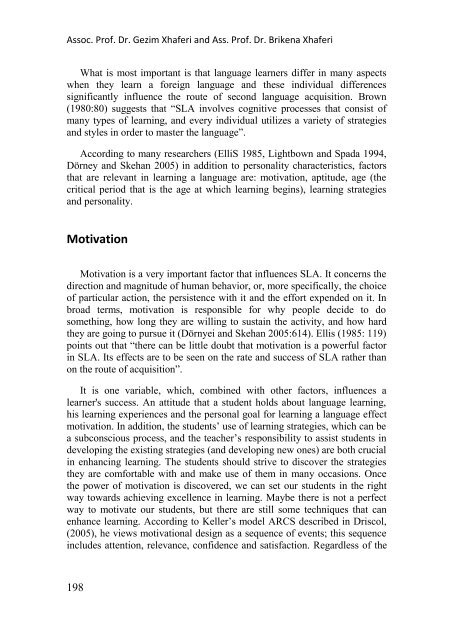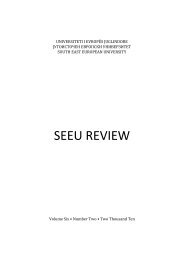SEEU Review vol. 5 Nr. 2 (pdf) - South East European University
SEEU Review vol. 5 Nr. 2 (pdf) - South East European University
SEEU Review vol. 5 Nr. 2 (pdf) - South East European University
You also want an ePaper? Increase the reach of your titles
YUMPU automatically turns print PDFs into web optimized ePapers that Google loves.
Assoc. Prof. Dr. Gezim Xhaferi and Ass. Prof. Dr. Brikena Xhaferi<br />
What is most important is that language learners differ in many aspects<br />
when they learn a foreign language and these individual differences<br />
significantly influence the route of second language acquisition. Brown<br />
(1980:80) suggests that “SLA in<strong>vol</strong>ves cognitive processes that consist of<br />
many types of learning, and every individual utilizes a variety of strategies<br />
and styles in order to master the language”.<br />
According to many researchers (ElliS 1985, Lightbown and Spada 1994,<br />
Dörney and Skehan 2005) in addition to personality characteristics, factors<br />
that are relevant in learning a language are: motivation, aptitude, age (the<br />
critical period that is the age at which learning begins), learning strategies<br />
and personality.<br />
Motivation<br />
Motivation is a very important factor that influences SLA. It concerns the<br />
direction and magnitude of human behavior, or, more specifically, the choice<br />
of particular action, the persistence with it and the effort expended on it. In<br />
broad terms, motivation is responsible for why people decide to do<br />
something, how long they are willing to sustain the activity, and how hard<br />
they are going to pursue it (Dörnyei and Skehan 2005:614). Ellis (1985: 119)<br />
points out that “there can be little doubt that motivation is a powerful factor<br />
in SLA. Its effects are to be seen on the rate and success of SLA rather than<br />
on the route of acquisition”.<br />
It is one variable, which, combined with other factors, influences a<br />
learner's success. An attitude that a student holds about language learning,<br />
his learning experiences and the personal goal for learning a language effect<br />
motivation. In addition, the students’ use of learning strategies, which can be<br />
a subconscious process, and the teacher’s responsibility to assist students in<br />
developing the existing strategies (and developing new ones) are both crucial<br />
in enhancing learning. The students should strive to discover the strategies<br />
they are comfortable with and make use of them in many occasions. Once<br />
the power of motivation is discovered, we can set our students in the right<br />
way towards achieving excellence in learning. Maybe there is not a perfect<br />
way to motivate our students, but there are still some techniques that can<br />
enhance learning. According to Keller’s model ARCS described in Driscol,<br />
(2005), he views motivational design as a sequence of events; this sequence<br />
includes attention, relevance, confidence and satisfaction. Regardless of the<br />
198

















